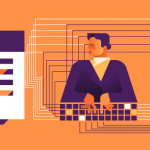
Learn why Data Loss Prevention (DLP) solutions are now an essential part of any company’s data security strategy.
With evolving data compliance requirements, large and frequent data breaches, and an increasing number of data repositories, a DLP solution has become a crucial element besides traditional perimeter and network security like firewalls, intrusion detection, and antivirus systems. We’ve gathered some common questions regarding DLP that will help you choose a DLP solution and enhance your data security strategy.
Read the 7 FAQs about Data Loss Prevention:
1. Why do you need a Data Loss Prevention (DLP) solution?
A DLP solution can help your organization ensure that sensitive information does not get accidentally or intentionally outside the corporate network or to a user without access. Sensitive data can be customers’ Personally Identifiable Information (PII), Protected Health Information (PHI) or Payment Card Information (PCI), the company’s Intellectual Property (IP) such as trade secrets, source code, etc.
If you want to prevent data leakage, theft, and exfiltration, then a DLP solution is an efficient safeguard and can provide your information security team with complete visibility into all sensitive data. With DLP software in place, you can protect data in each state (in motion and at rest on desktops, laptops, etc.) and thus avoid operational disruptions, regulatory issues, penalties, and reputational damage that result from data breaches.
Check out the cost of a data breach in 2021.
2. How do DLP policies work?
Data Loss Prevention policies are sets of rules for detecting, reporting, and blocking the transfer of sensitive content. A customizable policy includes several elements, such as policy action (report only, blocking and reporting of sensitive content transfers), policy type (standard, outside hours, or outside network), exit points, etc. Besides customizable policies that IT admins can set up, some DLP tools offer predefined policy templates designed for specific datasets (such as data protected by the GDPR, HIPAA, or PCI DSS). The advantage of DLP policies is that they efficiently discover, monitor, and control specific sensitive data, such as credit card numbers or social security numbers, while employees can freely manage data outside these categories.
DLPs perform content inspection and contextual analysis of data while moving across a network, used on a managed endpoint device, or resting in file servers. Through content inspection, companies can detect data containing PII, health or financial information, and data protected under different regulations. Combined with contextual detection that allows or blocks data transfers based on file type, file size, related regular expressions, etc., DLP tools provide an efficient approach to data leakage prevention.
By enforcing DLP security policies, you can reduce the risk of insider threats and meet the compliance requirements of different regulatory frameworks.
Test and validate your DLP policies
3. What types of data loss prevention exist?
You can choose from three types of data loss prevention solutions: endpoint, network, and cloud.
Network DLPs protect data in transit, stopping data loss over email, webmail, web applications, etc. While efficient and easy to implement, network DLPs can only protect data when computers are connected to the company network and cannot prevent data transfers onto portable devices.
Endpoint DLPs can prevent data leaks at their earliest stage – when end users initiate transfers of sensitive data from their computers. These solutions also offer more extensive data protection coverage, including content discovery on the endpoint, data leakage prevention through portable storage devices, and safeguarding data regardless of an endpoint’s physical location.
Read the top 3 reasons to use endpoint Data Loss Prevention.
With cloud DLPs, companies can monitor and protect sensitive data across cloud storage and emails and prevent data leaks through real-time data protection actions such as data encryption or deletion.
4. What can DLP detect?
DLP can detect potential data breaches and data exfiltration attempts; it can also prevent them by discovering, monitoring, and controlling confidential data. When DLP rules find a policy violation, alerts are triggered.
DLP policies can block prohibited activities, like inappropriate sharing of sensitive information via email, messaging apps, etc., thus reducing the risk of insider threats. As you plan your DLP policies, it’s essential to identify the business processes that touch your sensitive items.
5. How can a DLP tool help with compliance?
Data Loss Prevention solutions can assist organizations in meeting compliance requirements by discovering PII stored on computers, stopping unauthorized sensitive data transfers through a multitude of exit points such as USB storage devices, file sharing applications, cloud storage, email, instant messaging applications, and more.
Some DLP tools offer predefined compliance profiles for data protection regulations such as the GDPR, CCPA, LGPD, HIPAA, or PCI DSS, thus ensuring an easier way to safeguard customer data. Organizations can also customize detection rules and contextual conditions that align with compliance requirements.
6. Does DLP protect data when an endpoint goes offline?
When employees work remotely, they may not always have a continuous internet connection. Without a DLP, you risk data loss and non-compliance with data protection laws and industry standards. By using a DLP solution that applies policies at the device level, you can ensure that data continues to be protected whether a computer is online or not. This means that DLP policies remain active, blocking unauthorized data transfers and storing logs locally until they reconnect to the company network.
7. How to implement DLP software?
After choosing your DLP provider, the best way to start DLP implementation is to roll out the solution in monitoring mode and preferably by departments. This allows you to fine-tune policies according to the departments’ needs and anticipate the DLP’s effect on your organization’s culture and operations. It’s also important to test your policies before going live because high volumes of false positives can frustrate support teams and disrupt normal business workflows. Blocking sensitive information transfers too soon may harm central business activities.
Also, keep in mind that DLP rules should be improved and adjusted over time. For this, involve all relevant stakeholders, and ask for feedback on new data types, formats, and transmission paths that aren’t listed in the current DLP strategy.
What other questions occur to you when thinking about Data Loss Prevention?
Frequently Asked Questions
The primary causes of data loss are:
- Human error;
- Malware infection and computer viruses;
- Theft;
- Hardware destruction.
The most relevant use cases when organizations should consider implementing Data Loss Prevention software are:
- Insider threat management;
- Customer data protection;
- Meeting compliance requirements;
- IP protection.
Data classification adds another layer of security when used with a DLP solution by allowing employees to mark highly sensitive documents. In this way, sensitive data becomes instantly recognizable to DLP solutions; scanning data classification tags makes it easier to ensure that the right policies are applied to restrict or block sensitive data transfers.
Download our free ebook on
Data Loss Prevention Best Practices
Helping IT Managers, IT Administrators and data security staff understand the concept and purpose of DLP and how to easily implement it.















